Bonsai Trees
Case Histories
Dwarf Cedar of Lebanon - (cedrus libani nana)
Cedar Bonsai Style: Triple Trunk
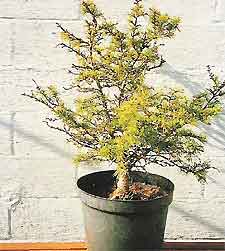
I first noticed this tree whilst walking around a nearby garden centre. It was one of about twenty and they were all in a sorry state, with many dead branches and much die-back.
I think that their poor condition was the result of a combination of being potbound, droughted and frost damaged.
They were being offered at a knockdown price due to their ill-health and I persuaded the manager to sell me two for the price of one. I was delighted with my bargain and studied the trees immediately upon my arrival home, confident that I could bring them back to good health.
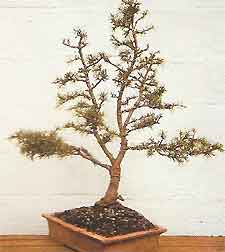
Although not a conventional multi trunk as the trunks emerged from above the base, I decided to try to emulate an actual cedar shape. I scrutinsed the tree carefully the next day and was so pleased with the obvious potential that I went back to the garden centre the following weekend to further examine the remaining cedars. Unfortunately they were no longer there and had been disposed of the day before, being considered unsuitable stock!
Never mind, at least I had picked the best two and saved them from certain death. I was thankful for that. The tree was planted in a larger flower pot and left untouched for the next year whilst it recovered and gained strength. By summer, it was apparent that health had been restored and so I pruned many unnecessary branches and wired the larger ones.
Cedar Bonsai History: Training
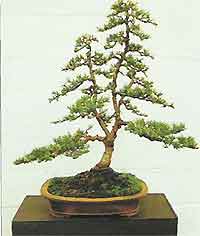
The following spring arrived and the tree was root pruned and planted in a bonsai pot. The roots were not in a wonderful condition, but were adequate and I was confident that fresh soil would aid their development. I exposed some of the surface roots to improve the buttress. These needed attention, but I decided not to prune them until the tree was established and growing strongly again.
For the first year the tree made little growth. I lightly fed and the foliage remained green, appearing healthy. The following year showed great improvement. In the spring the branches were covered in new growth and I began to feed more heavily. I did not prune at all, to allow maximum root development.
After establishing well the next year, in the spring I carefully lifted the tree out of the pot and looked at the roots. I was pleased to see an excellent healthy root system had now developed. Although not pot bound the tree was obviously much stronger and I repotted into a slightly shallower pot, changing the viewing angle.
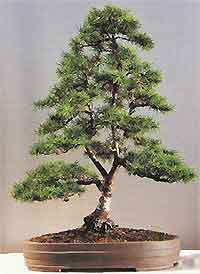
I improved the base by pruning off some rather ugly surface roots. That summer, the tree was growing with vigour and looked very healthy. It was time for some serious refinement. I lightly pruned the shoots, removed some surplus branches and completely wired everything, carefully positioning each twig.
The tree was not repotted until spring two years later. I had recently purchased a large, grey Japanese pot with another bonsai in mind, but whilst root pruning the cedar, placed it in this pot purely out of curiosity. I was surprised that the pot suited the tree so well. Should I use this pot? What about the tree that it was intended for? I decided that the cedar was the better tree and therefore deserved this pot.
Following potting , the tree was allowed to grow freely to help thicken the trunks. Despite being a dwarf variety it has made considerable growth over the years which has improved the overall appearance and it now resembles a natural cedar shape. I count myself fortunate that I managed to rescue this tree from a miserable past and give it the happy future that it deserves.
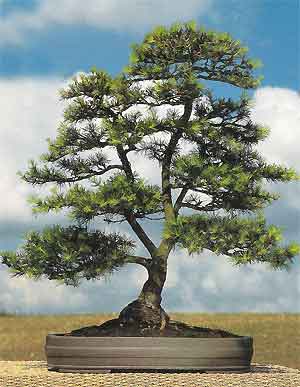
 I first noticed this tree whilst walking around a nearby garden centre. It was one of about twenty and they were all in a sorry state, with many dead branches and much die-back.
I first noticed this tree whilst walking around a nearby garden centre. It was one of about twenty and they were all in a sorry state, with many dead branches and much die-back. Although not a conventional multi trunk as the trunks emerged from above the base, I decided to try to emulate an actual cedar shape. I scrutinsed the tree carefully the next day and was so pleased with the obvious potential that I went back to the garden centre the following weekend to further examine the remaining cedars. Unfortunately they were no longer there and had been disposed of the day before, being considered unsuitable stock!
Although not a conventional multi trunk as the trunks emerged from above the base, I decided to try to emulate an actual cedar shape. I scrutinsed the tree carefully the next day and was so pleased with the obvious potential that I went back to the garden centre the following weekend to further examine the remaining cedars. Unfortunately they were no longer there and had been disposed of the day before, being considered unsuitable stock! The following spring arrived and the tree was root pruned and planted in a bonsai pot. The roots were not in a wonderful condition, but were adequate and I was confident that fresh soil would aid their development. I exposed some of the surface roots to improve the buttress. These needed attention, but I decided not to prune them until the tree was established and growing strongly again.
The following spring arrived and the tree was root pruned and planted in a bonsai pot. The roots were not in a wonderful condition, but were adequate and I was confident that fresh soil would aid their development. I exposed some of the surface roots to improve the buttress. These needed attention, but I decided not to prune them until the tree was established and growing strongly again. I improved the base by pruning off some rather ugly surface roots. That summer, the tree was growing with vigour and looked very healthy. It was time for some serious refinement. I lightly pruned the shoots, removed some surplus branches and completely wired everything, carefully positioning each twig.
I improved the base by pruning off some rather ugly surface roots. That summer, the tree was growing with vigour and looked very healthy. It was time for some serious refinement. I lightly pruned the shoots, removed some surplus branches and completely wired everything, carefully positioning each twig.